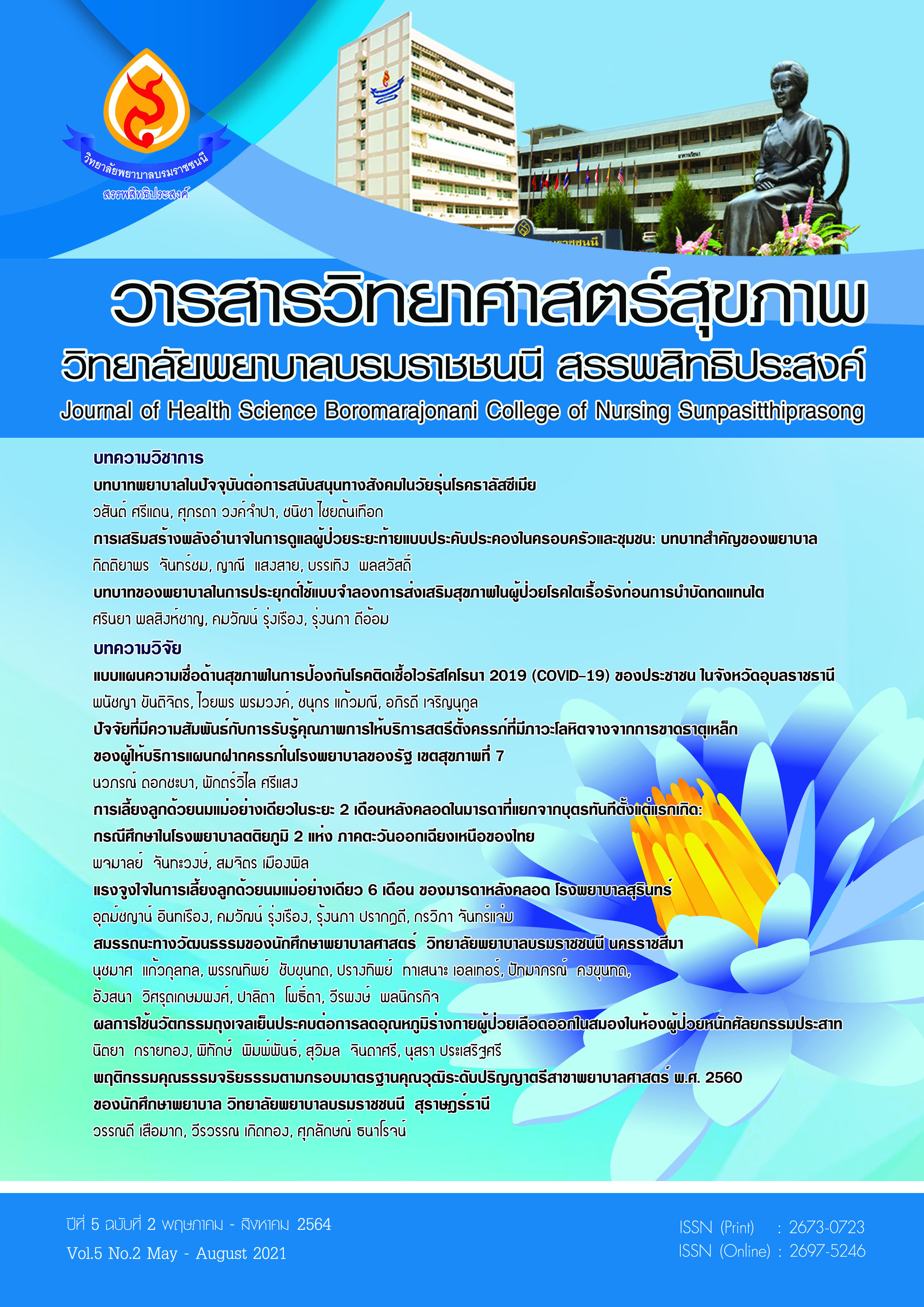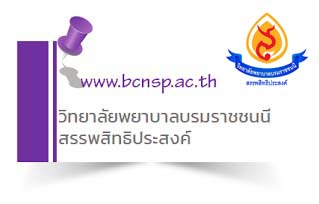ผลการใช้นวัตกรรมถุงเจลเย็นประคบต่อการลดอุณหภูมิร่างกาย ผู้ป่วยเลือดออกในสมองในห้องผู้ป่วยหนักศัลยกรรมประสาท
คำสำคัญ:
นวัตกรรมถุงเจลเย็นประคบ, การลดอุณหภูมิร่างกาย, เลือดออกในสมองบทคัดย่อ
อุณหภูมิร่างกายที่สูงขึ้นทำให้การบาดเจ็บของสมองเพิ่มขึ้นในผู้ป่วยเลือดออกในสมอง การวิจัยครั้งนี้มีวัตถุประสงค์เพื่อศึกษาผลการลดอุณหภูมิกายของนวัตกรรมถุงเจลเย็นประคบ เป็นการวิจัยแบบสุ่มตัวอย่างเปรียบเทียบโดยไม่ปิดบังแบบไปข้างหน้า (A prospective randomized, nonblinded trial) กลุ่มตัวอย่างเป็นผู้ป่วยศัลยกรรมประสาทที่มีเลือดออกในสมองที่มีอุณหภูมิกายสูงมากกว่าหรือเท่ากับ 37.9 °C ถึง 39.5 °C จำนวน 50 ราย สุ่มเข้ากลุ่มทดลองใช้นวัตกรรมถุงเจลเย็นประคบ 25 รายและกลุ่มควบคุมใช้วิธีลดไข้ด้วยน้ำธรรมดาตามวิธีปกติ (Tepid sponge) 25 รายโดยวิธีการจับฉลาก วัดอุณหภูมิกายหลังการทดลอง 15 นาที 30 นาที และ 60 นาที วิเคราะห์ข้อมูลโดยใช้สถิติเชิงพรรณนา ร้อยละ ค่าเฉลี่ย และส่วนเบี่ยงเบนมาตรฐาน เปรียบเทียบเปรียบเทียบความแตกต่างค่าเฉลี่ยอุณหภูมิร่างกายของกลุ่มควบคุมและกลุ่มทดลองโดยใช้สถิติ Pair t-test ผลการวิจัยพบว่า กลุ่มทดลองและกลุ่มควบคุมมีอุณหภูมิร่างกายเฉลี่ยก่อนการทดลองเท่ากับ 38.44 องศาเซลเซียส (SD ± 0.51) และ 38.40 องศาเซลเซียส (S.D. ± 0.33) ตามลำดับ หลังการทดลอง 15 นาที พบว่า ไม่มีความแตกต่างของอุณหภูมิร่างกายระหว่างกลุ่มทดลองและกลุ่มควบคุม หลังการทดลอง 30 นาที และ 60 นาที พบว่า มีความแตกต่างของอุณหภูมิร่างกาย ระหว่างกลุ่มทดลอง (37.10 (S.D. ± 0.69)), (36.9 (S.D. ± 0.71)) และกลุ่มควบคุม (37.56 (S.D. ± 0.84)), (37.92 (S.D. ± 0.75)) อย่างมีนัยสำคัญทางสถิติ (t = 2.1, P< 0.05), (t = 4.8, P< 0.01) นอกจากนี้พบว่าไม่เกิดภาวะแทรกซ้อนจากความเย็นหลังการใช้นวัตกรรมถุงเจลเย็นประคบในกลุ่มทดลอง ได้แก่ อาการหนาวสั่น ผิวหนังไหม้จากความเย็นและหัวใจเต้นผิดปกติชนิด Ventricular Fibrillation ผลการศึกษาสรุปได้ว่านวัตกรรมถุงเจลเย็นประคบสามารถใช้ในการลดอุณหภูมิร่างกายผู้ป่วยศัลยกรรมระบบประสาทที่มีเลือดออกในสมองได้มากกว่าการเช็ดตัวด้วยน้ำตามวิธีปกติ และมีความปลอดภัย เป็นวิธีที่สะดวก ประหยัด และเป็นทางเลือกในการลดไข้ให้ผู้ป่วยในภาวะที่ขาดแคลนบุคลากรทางการพยาบาล
เอกสารอ้างอิง
Yenari MA, Han HS. Neuroprotective mechanisms of hypothermia in brain ischaemia. Nature Reviews Neuroscience 2012;13:267-78.
Niven DJ, Laupland KB. Pyrexia: aetiology in the ICU. Critical Care 2016;20:1-9.
Wang H, Wang B, Normoyle KP, Jackson K, Spitler K, Sharrock MF, et al. Brain temperature and its fundamental properties: a review for clinical neuroscientists. Frontiers in neuroscience 2014;8:307.
Tomura S, de Rivero Vaccari JP, Keane RW, Bramlett HM, Dietrich WD. Effects of therapeutic hypothermia on inflammasome signaling after traumatic brain injury. Journal of Cerebral Blood Flow & Metabolism 2012;32:1939-47.
Wang H, Kim M, Normoyle KP, Llano D. Thermal regulation of the brain—an anatomical and physiological review for clinical neuroscientists. Frontiers in neuroscience 2016;9:528.
Jefferies S, Saxena M, Young P. Paracetamol in critical illness: a review. Critical Care and Resuscitation 2012;14:74.
Kulstad E, Caherty HP. Devices and methods for controlling patient temperature [Internet]. 2013 [cited 2021 Jun 4]. Avaiable form: https://patents.google.com/patent/EP2401023A2
Chan E, Chen W, Assam P. External cooling methods for treatment of fever in adults: a systematic review. JBI Evidence Synthesis. 2010;8:793-825.
Lewis SR, Evans DJ, Butler AR, Schofield‐Robinson OJ, Alderson P. Hypothermia for traumatic brain injury. Cochrane Database of Systematic Reviews 2017;9:CD001048. doi: 10.1002/14651858.CD001048.pub5.
Lumprom O, Songwathana P. Evidence-based Fever Management in Patients with Traumatic Brain Injury: A Case Study. Songklanagarind Journal of Nursing 2017;37: 147-56.
วาสนา ธนเศรษฐ, อภิรดี เจริญจรรยากุล, อุไรวรรณ ทองบำเพ็ญ, รณิดา สารวรางค์กูล, จิณฐิมา คูเรืองรัศมี. ผลของการใช้นวัตกรรมผ้าห่มเย็นต่อการลดอุณหภูมิร่างกายในผู้ป่วยศัลยกรรมระบบประสาทและสมองที่มีอุณหภูมิร่างกายสูง. วารสารวิทยาลัยพยาบาลบรมราชชนนี กรุงเทพ 2558;31:70-81.
Poli S, Purrucker J, Priglinger M, Diedler J, Sykora M, Popp E, et al. Induction of cooling with a passive head and neck cooling device: effects on brain temperature after stroke. Stroke 2013;44:708-13.
นิรันดร์ นายกชน, ทิตยา พุฒิคามิน, อำนาจ กิจควรดี. ประสิทธิภาพของเครื่องมือให้ความเย็นเฉพาะที่บริเวณศีรษะและคอต่อการลดอุณหภูมิเทียบเคียงสมองในผู้ป่วยบาดเจ็บที่สมองรุนแรง. วารสารสมาคมพยาบาลฯ สาขาภาคตะวันออกเฉียงเหนือ 2554;29:40-9.
Polderman KH, Herold I. Therapeutic hypothermia and controlled normothermia in the intensive care unit: practical considerations, side effects, and cooling methods. Critical care medicine 2009;37:1101-20.
McCormick M, Hippensteel CD. Innovative Education Improves Patient Safety and Staff Satisfaction [Internet]. 2016 [cited 2021 Jun 4]. Avaiable form: http://2016roundtablediscussions.s3.amazonaws.com/McCormick_Hippensteel_Innovative+Education+Improves+Patient+Safety+and+Staff+Satisfaction_FINAL.pdf
Georgiou A, Manara A. Role of therapeutic hypothermia in improving outcome after traumatic brain injury: a systematic review. British journal of anaesthesia 2013;110:357-67.
Liu Y-H, Shang Z-D, Chen C, Lu N, Liu Q-F, Liu M, et al. ‘Cool and quiet’therapy for malignant hyperthermia following severe traumatic brain injury: A preliminary clinical approach. Experimental and therapeutic medicine 2015;9:464-8.
Law ZK, Appleton JP, Bath PM, Sprigg N. Management of acute intracerebral haemorrhage–an update. Clinical Medicine 2017;17:166.
Andrews PJ, Verma V, Healy M, Lavinio A, Curtis C, Reddy U, et al. Targeted temperature management in patients with intracerebral haemorrhage, subarachnoid haemorrhage, or acute ischaemic stroke: consensus recommendations. British journal of anaesthesia 2018;121:768-75.
Choi HA, Badjatia N, Mayer SA. Hypothermia for acute brain injury—mechanisms and practical aspects. Nature Reviews Neurology 2012;8:214-22.
Wood T, Thoresen M, editors. Physiological responses to hypothermia. Seminars in fetal and neonatal medicine 2015;20:87-96. doi: https://doi.org/10.1016/j.siny.2014.10.005
ดาวน์โหลด
เผยแพร่แล้ว
รูปแบบการอ้างอิง
ฉบับ
ประเภทบทความ
สัญญาอนุญาต
บทความที่ได้รับการตีพิมพ์เป็นลิขสิทธิ์ของวารสารวิทยาศาสตร์สุขภาพ วิทยาลัยพยาบาลบรมราชชนนี สรรพสิทธิประสงค์ ข้อความที่ปรากฏในบทความแต่ละเรื่องเป็นความคิดเห็นส่วนตัวของผู้เขียนแต่ละท่านไม่เกี่ยวข้องกับวิทยาลัยพยาบาลบรมราชชนนี สรรพสิทธิประสงค์ และคณาจารย์ท่านอื่นๆ ในวิทยาลัยพยาบาลฯ ความรับผิดชอบเกี่ยวกับบทความแต่ละเรื่องผู้เขียนจะรับผิดชอบของตนเอง



